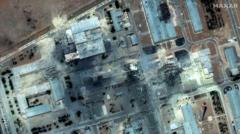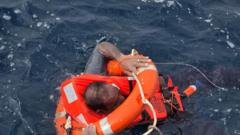The recent loss of a U.S. Navy fighter jet during landing operations has highlighted safety vulnerabilities aboard the USS Harry S. Truman, which is currently stationed in a region with increasing geopolitical tensions. With two jets lost in under two weeks and a backdrop of ongoing military operations against Houthi militias, the incidents raise serious discussions regarding the operational effectiveness and safety protocols of U.S. military assets.
Second U.S. Navy Jet Mishap Raises Concerns Over Carrier Operations in Red Sea

Second U.S. Navy Jet Mishap Raises Concerns Over Carrier Operations in Red Sea
Another F/A-18 Super Hornet from the USS Harry S. Truman has been lost, drawing attention to the safety protocols and geopolitical tensions in the region.
For the second time in less than two weeks, the United States Navy has reported the loss of a fighter jet from the aircraft carrier USS Harry S. Truman, stationed in the Red Sea. The incident occurred on Tuesday when an F/A-18 Super Hornet was attempting to land on the carrier's flight deck. The arrestment system, a crucial mechanism designed to halt the aircraft upon landing, malfunctioned, leading to the aircraft going overboard. Fortunately, both pilots managed to eject and sustain only minor injuries, later rescued by a helicopter.
This incident follows a similar mishap that took place just days earlier when another F/A-18 Super Hornet, along with a tow tractor, fell off the Truman. This previous accident was attributed to loss of control during the carrier's maneuvers to counter potential threats posed by Houthi missiles and drones. For over a year, the Yemeni Houthi group has been actively targeting commercial and military vessels in the Red Sea as part of their campaign, which they claim supports the people of Gaza and Hamas.
In a noteworthy development, the U.S. and the Houthis recently reached an agreement to pause American airstrikes against the group, contingent upon their promise to refrain from further attacks on U.S. vessels in the Red Sea. President Trump commented on the negotiations, stating, “They have capitulated, but we will take their word,” signaling a potential easing of hostilities in the region. This comes on the heels of Operation Rough Rider, a military campaign that has seen upward of $1 billion spent against the Houthis, with more than 800 targets hit in Yemen.
The USS Harry S. Truman has experienced a string of significant incidents since its deployment to the Middle East in September. In February, it collided with a commercial vessel near Port Said, Egypt. Additionally, in December, an F/A-18 Super Hornet was accidentally shot down by the USS Gettysburg, a guided-missile cruiser accompanying the Truman. Despite these setbacks, the pilots involved in these incidents have all been successfully recovered.
As the U.S. Navy continues to operate in a tense and complex geopolitical landscape, the implications of these incidents raise critical questions about safety measures and the ongoing commitment to military readiness in the region.





















